Yellowstone National Park: Caldera and Hot Spot!
This post continues my series of photographic essays from a 12-day five-state tour of National Parks and Monuments July 12-24, 2019. See the chronological archives for this series that began July 26: https://stevejonesgbh.com/blog/
The immediate prior Post covered the two days we based in West Yellowstone, Montana focusing on the captivating Greater Yellowstone Ecosystem, taking us through our exit east toward Cody, WY: https://stevejonesgbh.com/wp-admin/post.php?post=5150&action=edit
Writers, researchers, and scholars have written volumes (shelves!) about the Yellowstone Caldera, the supervolcano that feeds the world’s largest group of hydrothermal features. The official Park Service Yellowstone pamphlet: At the heart of Yellowstone’s past, present, and future lies a supervolcano. Huge volcanic eruptions occurred here, the latest about 631,000 years ago. The center of what is now the park collapsed, forming a 30-by-45-mile caldera, or basin. The heat powering those eruptions still fuels the park’s geysers, hot springs, fumaroles, and mudpots.
Because so much of the underlying science and interpretation is available in written and electronic form, I leave its discovery to you. I will simply offer the following:
- My photos
- My somewhat-informed observations, reflections, and ruminations
- Implications for Life and Living
- Lots of reasons for Humility and Inspiration
Photo Gallery of Yellowstone’s Hydrothermal Features
This is it — my photo of one of the two eruptions we witnessed while at the Old Faithful Geyser Basin. What would a Yellowstone visit be without seeing this iconic symbol!
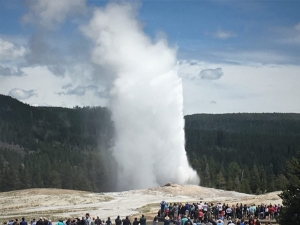
Along the Firehole River we stopped at Lower Geyser Basin (Fountain Paint Pot and Great Fountain Geyser) and Midway Geyser Basin (Grand Prismatic Spring) on our journey south to Old Faithful. Water vapor clouds rose from steaming vents and hot flows in the cool morning air along the river. I loved the interaction among water, low clouds, and morning sunshine. Amazing that exquisite beauty derives from the nearly unfathomable forces just below the surface that someday (it could be next year…or millennia hence) could once again darken the skies globally for weeks, months, years…threatening life on Earth as we know it. Regardless, I felt no fear as we toured this land of hydrothermal wonder!
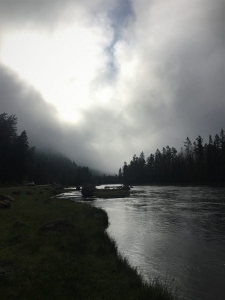
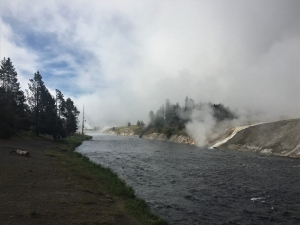
Bacterial and extremophile life (microorganisms, especially an archaean, that live in conditions of extreme temperature, acidity, alkalinity, or chemical concentration) abounds in the scalding waters. Note the rich color of life and chemical abundance of the overland flow.
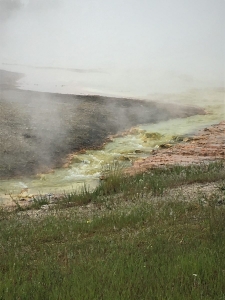
Clouds fascinate me, whether a towering August thunderstorm or hot-springs mists ascending through the morning sun. Nature reminds me often that in the full scheme of things I am nothing. One of seven billion human residents during an instant of time on a planet 4.5 billion years old. On this Earth, this mote of dust in a 13.5 billion-year-old universe. Our home planet orbiting one of the Milky Way’s 200 billion stars…an inconsequential star in the far reaches of a Milky Way spiral arm, 25,000 light years from our galaxy’s center. The Milky way is one of two trillion such galaxies. And even as I am nothing, I am everything. Utterly insignificant as I may be, I embrace my commitment…my obligation…to do all I can to make tomorrow brighter through wisdom, knowledge, and hard work. Experiencing Yellowstone hardened and sharpened my resolve to make sure we don’t screw up this one chance…this last chance…to do it right! All my experiences in Nature generate both deep humility (for I am nothing) and absolute inspiration (for if I do not act, then who will?).
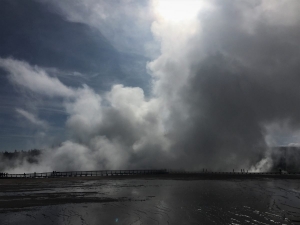
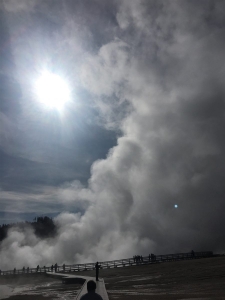
Yellowstone multiplied my dual feelings of inspiration and humility. I just couldn’t get enough of it — both the Park and those transcendent dual sentiments. As I viewed this tortured (and captivatingingly beautiful) landscape in mid-summer, I couldn’t help but imagine the scene in sub-zero January. I’ve said in prior Posts from this National Parks tour, I’d love to experience a full year on-site in and around these Parks watching the seasons advance (and retreat) day-by-day. Whether a full year, decade, century, or millennia, nothing in Nature is static.
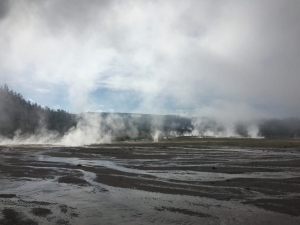

I must ask for some forbearance regarding my absolute accuracy in these captions. I saw so much, so different, and so quickly that I cannot recall all details and feature identification. Lower left, I believe is Grand Prismatic Spring (The Grand Prismatic Spring in Yellowstone National Park is the largest hot spring in the United States, and the third largest in the world, after Frying Pan Lake in New Zealand and Boiling Lake in Dominica. It is located in the Midway Geyser Basin. Wikipedia). It’s 160′ deep and registers 160-degrees F. That’s a bison resting within the thermal zone below left, along with a fly-by raven I accidentally captured in the frame. I saw reports of bison seeking warmth during winter’s bitter cold only to succumb to noxious vapors.
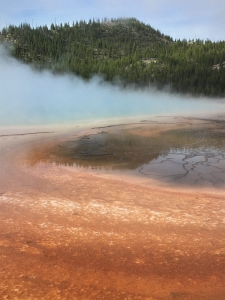
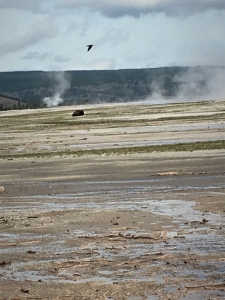
I am grateful for the Park Service boardwalks that bring me close enough to the thermal features to see, feel, inhale, and hear the activity. Even with the boardwalks an occasional visitor foolishly tempts fate. From My YellowstonePark.com (June 27, 2017):
Colin Nathaniel Scott, 23, of Portland, Oregon, slipped and fell to his death in a hot spring near Porkchop Geyser Tuesday, June 7, 2016. He and his sister, Sable Scott, illegally left the boardwalk and walked more than 200 yards in the Norris Geyser Basin when the accident happened. The victim’s sister reported the incident to rangers Tuesday afternoon. Sadly, this tragic incident was the second known geyser accident in the park in one week. Earlier in the week, a 13-year-old boy was burned on his ankle and foot on June 6, 2016, after his dad slipped while carrying his son near Old Faithful. The father apparently also suffered burns. According to the National Park Service, the duo had walked off the designated trail in the thermal area. The boy was hospitalized following the incident.
I stayed on the boardwalks and designated trails. My senses signaled a hostile and dangerous place, even as I embraced the full dose of beauty, magic, wonder, and awe it afforded.
The Place Where Hell Bubbled Up
In 1807 Manuel Lisa’s Missouri Fur Trading Company constructed Fort Raymond at the confluence of the Bighorn and Yellowstone Rivers as a center for trading with the Indians. To attract clients, Lisa sent John Colter on a harrowing 500-mile journey through untracked Indian country. A veteran of the Lewis and Clark Expedition, Colter was a man born “for hardy indurance of fatigue, privation and perils.” Part of his route in 1807-8 is open to conjecture, but he is known to have skirted the northwest shore of Yellowstone Lake and crossed the Yellowstone River near Tower Falls, where he noted the presence of “Hot Spring Brimstone.” Although a thermal area near present-day Cody, Wyo, later became famous among trappers as “Colter’s Hell,” Colter is more celebrated as the first white man known to have entered Yellowstone. The privations of a trapper’s life and a narrow escape from the Blackfeet in 1808 prompted him to leave the mountains forever in 1810. But he was the pioneer, and for three decades a procession of beaver hunters followed in his footsteps (from a National Park Service website).
More from the website: In 1827 a Philadelphia newspaper printed a letter from a trapper who described his experiences hunting furs and fighting Blackfeet in Yellowstone. This letter was the first published description of the region:
on the south borders of this lake is a number of hot and boiling springs some of water and others of most beautiful fine clay and resembles that of a mush pot and throws its particles to the immense height of from twenty to thirty feet in height. The clay is white and pink and water appear fathomless as it appears to be entirely hollow underneath. There is also a number of places where the pure sulphor is sent forth in abundance one of our men visited one of these whilst taking his recreation at an instan [sic] made his escape when an explosion took place resembling that of thunder. During our stay in that quarter I heard it every day…
A turquoise pool and boiling mudpots typify the various thermal zones. I’ve written from time to time about experiencing Nature’s pleasurable terror (https://www.indiebound.org/book/9781489713094 p. 74). There is a parallel to the magnificently dangerous hydrothermal features at Yellowstone.
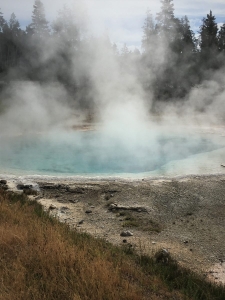
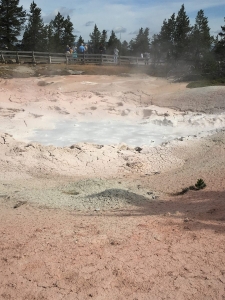
Continuing from the earlier Park Service website: In 1856 a Kansas City newspaper editor rejected as patent lies Bridger’s lucid description of the Yellowstone wonders. Perhaps this sort of refusal to believe the truth about “the place where Hell bubbled up,” as Bridger (Jim Bridger, early trapper and frontiersman) called Yellowstone, led him and other trappers to embellish their accounts with false detail. Frankly, I found some 163 years later no need for embellishment. Nothing could exceed Nature’s own exquisite real-life embellishment.
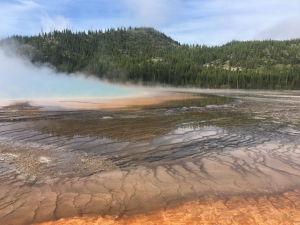
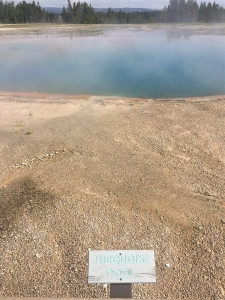
More from the website: Although Yellowstone had been thoroughly tracked by trappers and miners, in the view of the Nation at large it was really “discovered” when penetrated by formal expeditions originating in the settlements of an expanding America. The first organized attempt to explore Yellowstone came in 1860. Capt. William F. Raynolds, a discerning Army engineer guided by Jim Bridger, led a military expedition that accomplished much but failed to penetrate the future park because of faulty scheduling and early snow.
By August 1870 a second expedition had been organized. They had shown that ordinary men, as well as hardened frontiersmen, could venture into the wilderness of Yellowstone… Far more important, however, was their enchantment and wonder at what they had seen and their success in publicizing these feelings. As Hedges later recalled, “I think a more confirmed set of sceptics never went out into the wilderness than those who composed our party, and never was a party more completely surprised and captivated with the wonders of nature.” Their reports stirred intense interest in Montana and attracted national attention. Members of the expedition wrote articles for several newspapers and Scribner’s Monthly magazine.
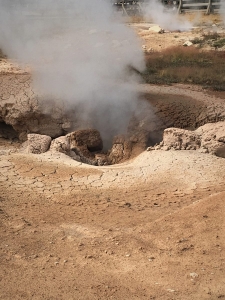
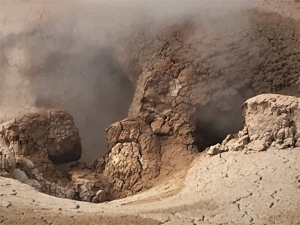
We spotted yet another bison resting in a geothermal flat… one without the evident steam vents and water bubbling to the surface.
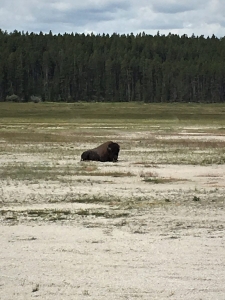
I surmised that the hydrothermal features, like most else in Nature, are not static. Below left the fallen dead tree evidences that what had once supported a 30-foot pine turned uninhabitable either chemically or thermally. The “bobby socks” forest stand below right died as conditions previously favorable yielded to chemically or thermally toxic conditions, the deadly waters now covering the soil surface. Throughout, the caldera is fluid, shifting across time and place. Again, I saw little actual shifting and changing during the snippets of time I watched any one place. I could only imagine what a day, month, year, decade, and longer would reveal.
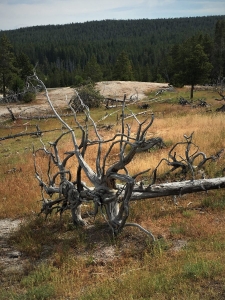
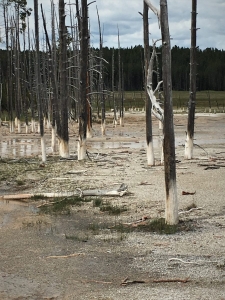
Both features below are in Old Faithful’s Upper Geyser Basin. The deep turquoise pool, appearing three-dimensional, is an aesthetic treat.
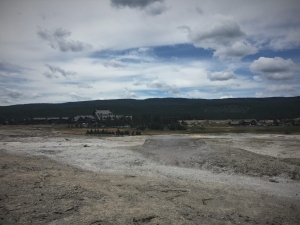

Old Faithful and Upper Geyser Basin
I had only dreamed of seeing Old Faithful. May the memory live with me for all my days. That is an oft repeated sentiment I feel and express as I wander and explore Nature wherever I am.
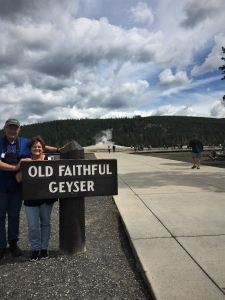
Hydrothermal features are frequently three-dimensional above and below ground.
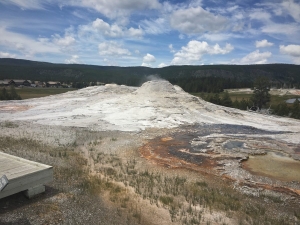
I will reserve discussion of National Park visitor impact and crowd management in a subsequent Post. Thousands of visitors witness every Old Faithful eruption. All observers below are eagerly awaiting the next one. I felt dismay seeing how many people sat transfixed by their digital devices. Are we reaching a threshold level, where we will remain forever captive to the device at the cost of understanding, appreciating, and connecting to the natural world that always will sustain us, and for which we must likewise always care and steward.

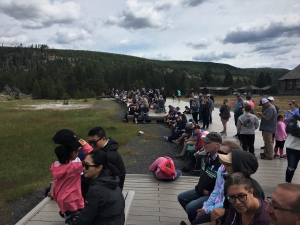
And here it is, needing no words to amplify the moment in time. The brief release that evidences the tremendous power lying hidden within. Scientists say the caldera last erupted 630,000 years ago, blasting away some 240 cubic miles of material… 1,000 times more debris than Mount Saint Helens blew in 1980.

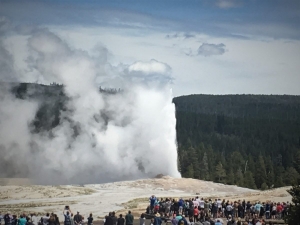
I remember the incredible force demonstrated that morning in May 1980. One thousand times more powerful?! Potentially globe-changing. From the April 15, 2015 National Geographic:
Two hundred years ago on April 10, the Indonesian volcano Tambora erupted, obliterating an entire tribe of people, cooling the Earth by several degrees, and causing famines and disease outbreaks around the world.
It remains the largest eruption on historical record: larger than the 1883 eruption of Krakatoa, and roughly 20 times bigger than Mount Vesuvius, which wiped the Italian town of Pompeii off the map. If such a cataclysmic event happened now, the results would be even messier, experts say.
“The consensus is that it would be absolutely devastating,” says Gillen D’Arcy Wood, an environmental historian at the University of Illinois at Urbana-Champaign. Our transportation, food, and humanitarian infrastructure are much better now than they were in the early 1800s, he says. “But we are also a planet of seven billion with a highly complicated global food and trade network.”
The most recent Yellowstone eruption ejected 6.7 times more material than Tambora! I don’t intend to fret the next Yellowstone caldera blow-out. Instead, we humans ourselves pose a greater existential threat to our sustainability. I want us to awaken to our vulnerability. I hold fast to my own Mission Statement: Employ writing and speaking to educate, inspire, and enable readers and listeners to understand, appreciate, and enjoy Nature… and accept and practice Earth Stewardship. We are indeed alone in the vast darkness of space… isolated by unfathomable time and distance.
Thoughts and Reflections
I wrote my books Nature Based Leadership (2016), Nature-Inspired Learning and Leading (2017), and Weaned Seals and Snowy Summits: Stories of Passion for Place and Everyday Nature (2019) to encourage all citizens to recognize and appreciate that every lesson for living, learning, serving, and leading is either written indelibly in or is powerfully inspired by Nature. All three are available on Amazon and other online sources.
Here are the four succinct lessons I draw from this Blog Post:
- Ironically, Nature’s geologic-time-scale power and violence (fueling the Yellowstone supervolcano) present gifts of beauty, magic, wonder, and awe.
- Understanding the Science underlying Nature’s attractions amplifies enjoyment, appreciation, and inspiration.
- Seeing Nature deeply sows and nurtures the seeds for informed and responsible Earth stewardship.
- Nature is spatial (and special) — connect viscerally to The Land wherever you are. Such union of personal passion to place will stir your heart, body, mind, spirit, and soul.
Inhale and absorb Nature’s elixir. May Nature Inspire and Reward you!
Note: All blog post images created & photographed by Stephen B. Jones unless otherwise noted. Please circulate images with photo credit: “©2019 Steve Jones, Great Blue Heron LLC. All Rights Reserved.”
Another Note: If you came to this post via a Facebook posting or by an another route, please sign up now (no cost… no obligation) to receive my Blog Post email alerts: https://stevejonesgbh.com/contact/
And a Third: I am available for Nature-Inspired Speaking, Writing, and Consulting — contact me at steve.jones.0524@gmail.com
Reminder of my Personal and Professional Purpose, Passion, and Cause
If only more of us viewed our precious environment through the filters I employ. If only my mission and vision could be multiplied untold orders of magnitude:
Mission: Employ writing and speaking to educate, inspire, and enable readers and listeners to understand, appreciate, and enjoy Nature… and accept and practice Earth Stewardship.
Vision:
- People of all ages will pay greater attention to and engage more regularly with Nature… and will accept and practice informed and responsible Earth Stewardship.
- They will see their relationship to our natural world with new eyes… and will understand more clearly their Earth home.
Tagline/Motto: Steve (Great Blue Heron) encourages and seeks a better tomorrow through Nature-Inspired Living!
Weaned Seals and Snowy Summits:
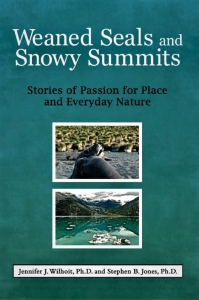
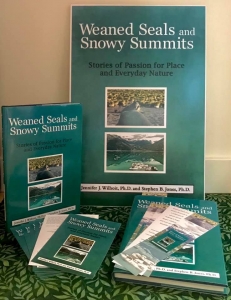
Jennifer and Steve: “We’re so proud to announce the publication and release of our first co-authored book, Weaned Seals and Snowy Summits: Stories of Passion for Place and Everyday Nature. This book is a collection of nature stories seeking to inspire deeper relationship with and care for this beautiful Earth.” Order your copy from your local indie bookstore, or find it on IndieBound: https://www.indiebound.org/book/9781489723529



